FDI in Indonesia: Current Situation, Promotion, and Constraint Factors
VerifiedAdded on 2022/09/12
|7
|1396
|38
Report
AI Summary
This report provides a comprehensive analysis of Foreign Direct Investment (FDI) in Indonesia. It begins with an overview of the current situation, highlighting the growth in FDI inflows and Indonesia's ranking in the world. The report then delves into the government's policies aimed at promoting and facilitating FDI, such as deregulation, tax incentives, and infrastructure projects. However, it also examines the constraint factors that have affected FDI inflows, including macroeconomic instability, corruption, and lack of transparency. The report concludes with recommendations to improve FDI in Indonesia, such as reducing the current account deficit, simplifying business approval measures, and eliminating terrorism. The analysis is supported by references to relevant academic literature and data from sources like UNCTAD and the World Bank. The report also includes a table depicting the rate of FDI inflows from 2016 to 2018.
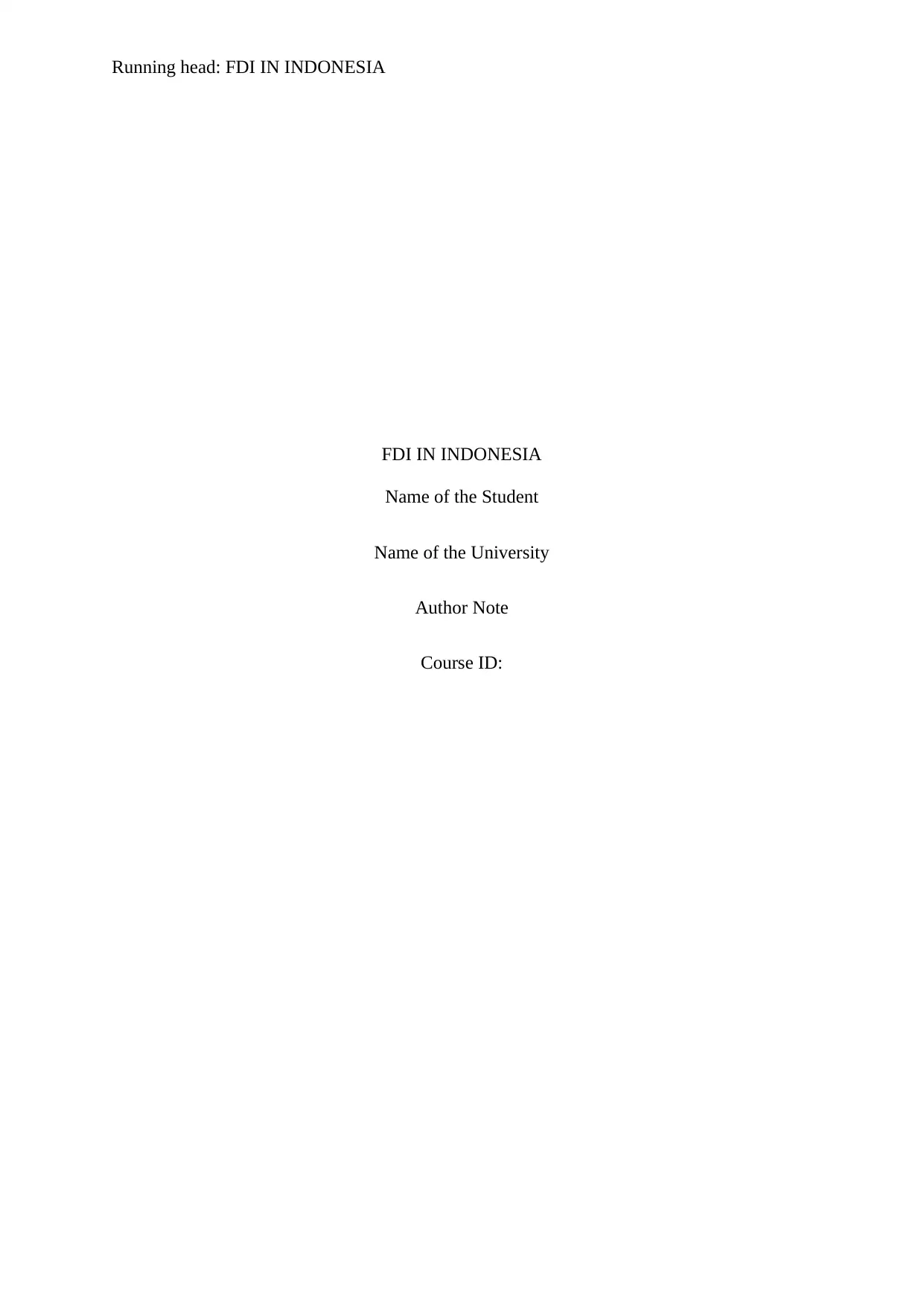
Running head: FDI IN INDONESIA
FDI IN INDONESIA
Name of the Student
Name of the University
Author Note
Course ID:
FDI IN INDONESIA
Name of the Student
Name of the University
Author Note
Course ID:
Paraphrase This Document
Need a fresh take? Get an instant paraphrase of this document with our AI Paraphraser
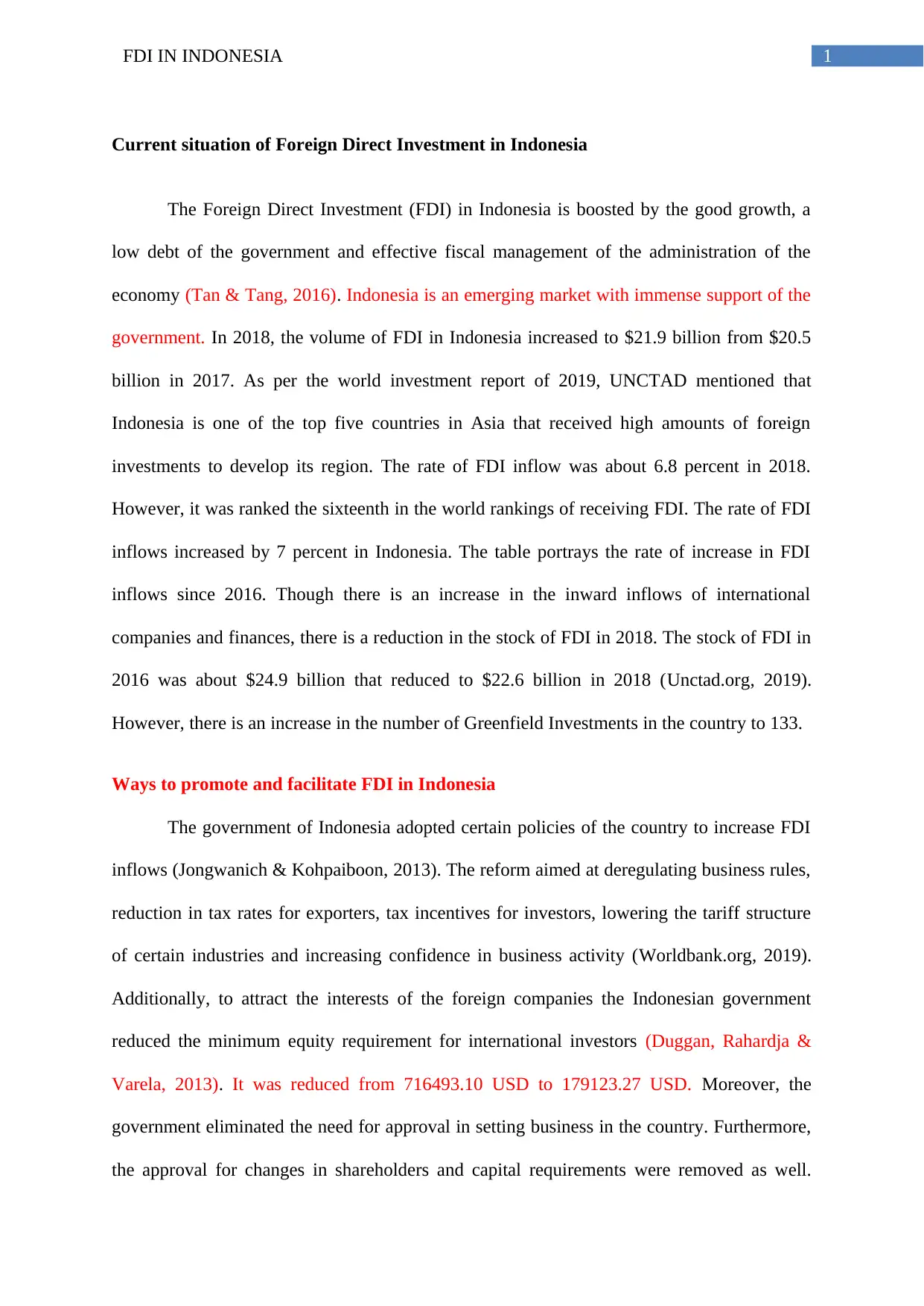
1FDI IN INDONESIA
Current situation of Foreign Direct Investment in Indonesia
The Foreign Direct Investment (FDI) in Indonesia is boosted by the good growth, a
low debt of the government and effective fiscal management of the administration of the
economy (Tan & Tang, 2016). Indonesia is an emerging market with immense support of the
government. In 2018, the volume of FDI in Indonesia increased to $21.9 billion from $20.5
billion in 2017. As per the world investment report of 2019, UNCTAD mentioned that
Indonesia is one of the top five countries in Asia that received high amounts of foreign
investments to develop its region. The rate of FDI inflow was about 6.8 percent in 2018.
However, it was ranked the sixteenth in the world rankings of receiving FDI. The rate of FDI
inflows increased by 7 percent in Indonesia. The table portrays the rate of increase in FDI
inflows since 2016. Though there is an increase in the inward inflows of international
companies and finances, there is a reduction in the stock of FDI in 2018. The stock of FDI in
2016 was about $24.9 billion that reduced to $22.6 billion in 2018 (Unctad.org, 2019).
However, there is an increase in the number of Greenfield Investments in the country to 133.
Ways to promote and facilitate FDI in Indonesia
The government of Indonesia adopted certain policies of the country to increase FDI
inflows (Jongwanich & Kohpaiboon, 2013). The reform aimed at deregulating business rules,
reduction in tax rates for exporters, tax incentives for investors, lowering the tariff structure
of certain industries and increasing confidence in business activity (Worldbank.org, 2019).
Additionally, to attract the interests of the foreign companies the Indonesian government
reduced the minimum equity requirement for international investors (Duggan, Rahardja &
Varela, 2013). It was reduced from 716493.10 USD to 179123.27 USD. Moreover, the
government eliminated the need for approval in setting business in the country. Furthermore,
the approval for changes in shareholders and capital requirements were removed as well.
Current situation of Foreign Direct Investment in Indonesia
The Foreign Direct Investment (FDI) in Indonesia is boosted by the good growth, a
low debt of the government and effective fiscal management of the administration of the
economy (Tan & Tang, 2016). Indonesia is an emerging market with immense support of the
government. In 2018, the volume of FDI in Indonesia increased to $21.9 billion from $20.5
billion in 2017. As per the world investment report of 2019, UNCTAD mentioned that
Indonesia is one of the top five countries in Asia that received high amounts of foreign
investments to develop its region. The rate of FDI inflow was about 6.8 percent in 2018.
However, it was ranked the sixteenth in the world rankings of receiving FDI. The rate of FDI
inflows increased by 7 percent in Indonesia. The table portrays the rate of increase in FDI
inflows since 2016. Though there is an increase in the inward inflows of international
companies and finances, there is a reduction in the stock of FDI in 2018. The stock of FDI in
2016 was about $24.9 billion that reduced to $22.6 billion in 2018 (Unctad.org, 2019).
However, there is an increase in the number of Greenfield Investments in the country to 133.
Ways to promote and facilitate FDI in Indonesia
The government of Indonesia adopted certain policies of the country to increase FDI
inflows (Jongwanich & Kohpaiboon, 2013). The reform aimed at deregulating business rules,
reduction in tax rates for exporters, tax incentives for investors, lowering the tariff structure
of certain industries and increasing confidence in business activity (Worldbank.org, 2019).
Additionally, to attract the interests of the foreign companies the Indonesian government
reduced the minimum equity requirement for international investors (Duggan, Rahardja &
Varela, 2013). It was reduced from 716493.10 USD to 179123.27 USD. Moreover, the
government eliminated the need for approval in setting business in the country. Furthermore,
the approval for changes in shareholders and capital requirements were removed as well.
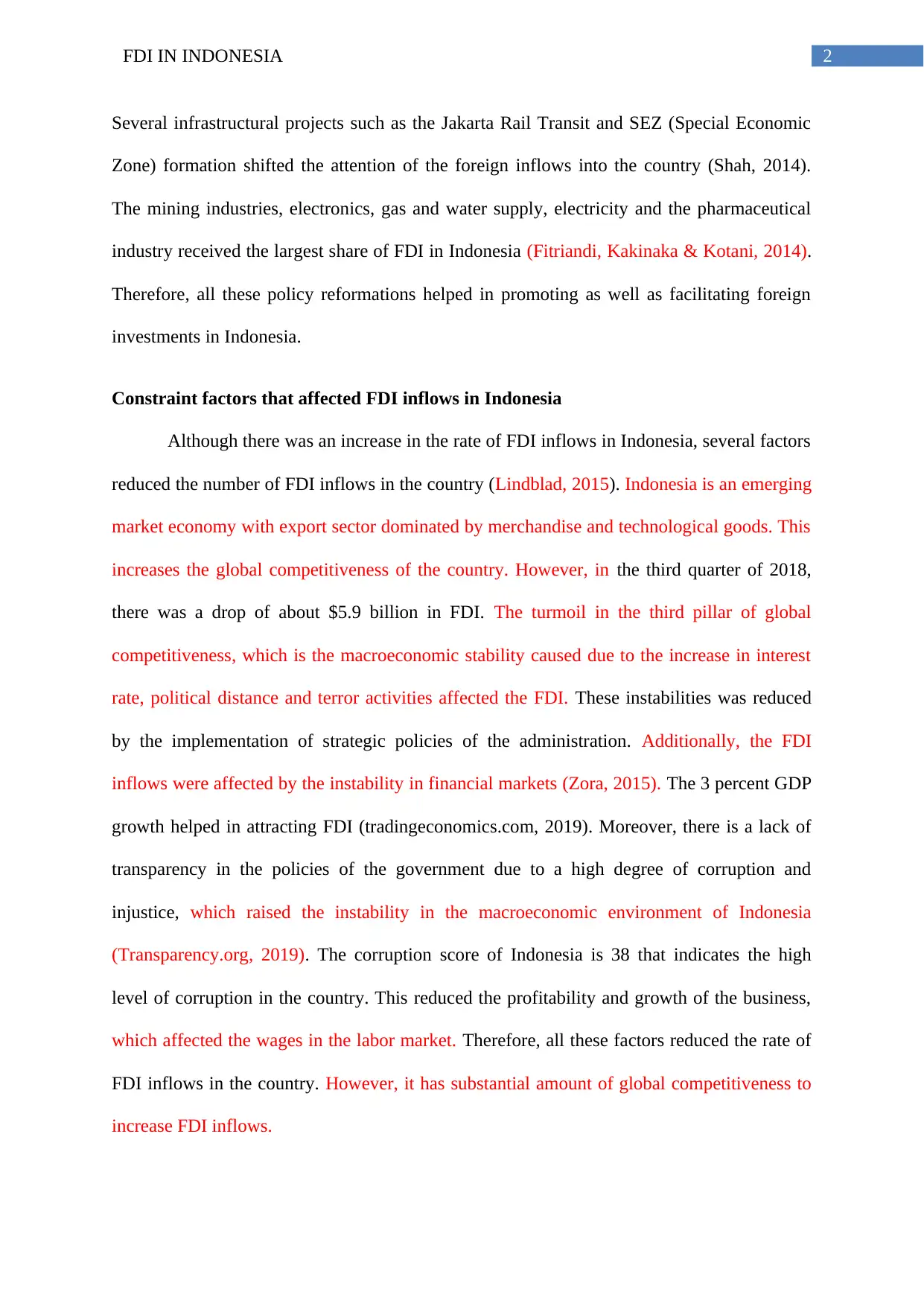
2FDI IN INDONESIA
Several infrastructural projects such as the Jakarta Rail Transit and SEZ (Special Economic
Zone) formation shifted the attention of the foreign inflows into the country (Shah, 2014).
The mining industries, electronics, gas and water supply, electricity and the pharmaceutical
industry received the largest share of FDI in Indonesia (Fitriandi, Kakinaka & Kotani, 2014).
Therefore, all these policy reformations helped in promoting as well as facilitating foreign
investments in Indonesia.
Constraint factors that affected FDI inflows in Indonesia
Although there was an increase in the rate of FDI inflows in Indonesia, several factors
reduced the number of FDI inflows in the country (Lindblad, 2015). Indonesia is an emerging
market economy with export sector dominated by merchandise and technological goods. This
increases the global competitiveness of the country. However, in the third quarter of 2018,
there was a drop of about $5.9 billion in FDI. The turmoil in the third pillar of global
competitiveness, which is the macroeconomic stability caused due to the increase in interest
rate, political distance and terror activities affected the FDI. These instabilities was reduced
by the implementation of strategic policies of the administration. Additionally, the FDI
inflows were affected by the instability in financial markets (Zora, 2015). The 3 percent GDP
growth helped in attracting FDI (tradingeconomics.com, 2019). Moreover, there is a lack of
transparency in the policies of the government due to a high degree of corruption and
injustice, which raised the instability in the macroeconomic environment of Indonesia
(Transparency.org, 2019). The corruption score of Indonesia is 38 that indicates the high
level of corruption in the country. This reduced the profitability and growth of the business,
which affected the wages in the labor market. Therefore, all these factors reduced the rate of
FDI inflows in the country. However, it has substantial amount of global competitiveness to
increase FDI inflows.
Several infrastructural projects such as the Jakarta Rail Transit and SEZ (Special Economic
Zone) formation shifted the attention of the foreign inflows into the country (Shah, 2014).
The mining industries, electronics, gas and water supply, electricity and the pharmaceutical
industry received the largest share of FDI in Indonesia (Fitriandi, Kakinaka & Kotani, 2014).
Therefore, all these policy reformations helped in promoting as well as facilitating foreign
investments in Indonesia.
Constraint factors that affected FDI inflows in Indonesia
Although there was an increase in the rate of FDI inflows in Indonesia, several factors
reduced the number of FDI inflows in the country (Lindblad, 2015). Indonesia is an emerging
market economy with export sector dominated by merchandise and technological goods. This
increases the global competitiveness of the country. However, in the third quarter of 2018,
there was a drop of about $5.9 billion in FDI. The turmoil in the third pillar of global
competitiveness, which is the macroeconomic stability caused due to the increase in interest
rate, political distance and terror activities affected the FDI. These instabilities was reduced
by the implementation of strategic policies of the administration. Additionally, the FDI
inflows were affected by the instability in financial markets (Zora, 2015). The 3 percent GDP
growth helped in attracting FDI (tradingeconomics.com, 2019). Moreover, there is a lack of
transparency in the policies of the government due to a high degree of corruption and
injustice, which raised the instability in the macroeconomic environment of Indonesia
(Transparency.org, 2019). The corruption score of Indonesia is 38 that indicates the high
level of corruption in the country. This reduced the profitability and growth of the business,
which affected the wages in the labor market. Therefore, all these factors reduced the rate of
FDI inflows in the country. However, it has substantial amount of global competitiveness to
increase FDI inflows.
⊘ This is a preview!⊘
Do you want full access?
Subscribe today to unlock all pages.

Trusted by 1+ million students worldwide
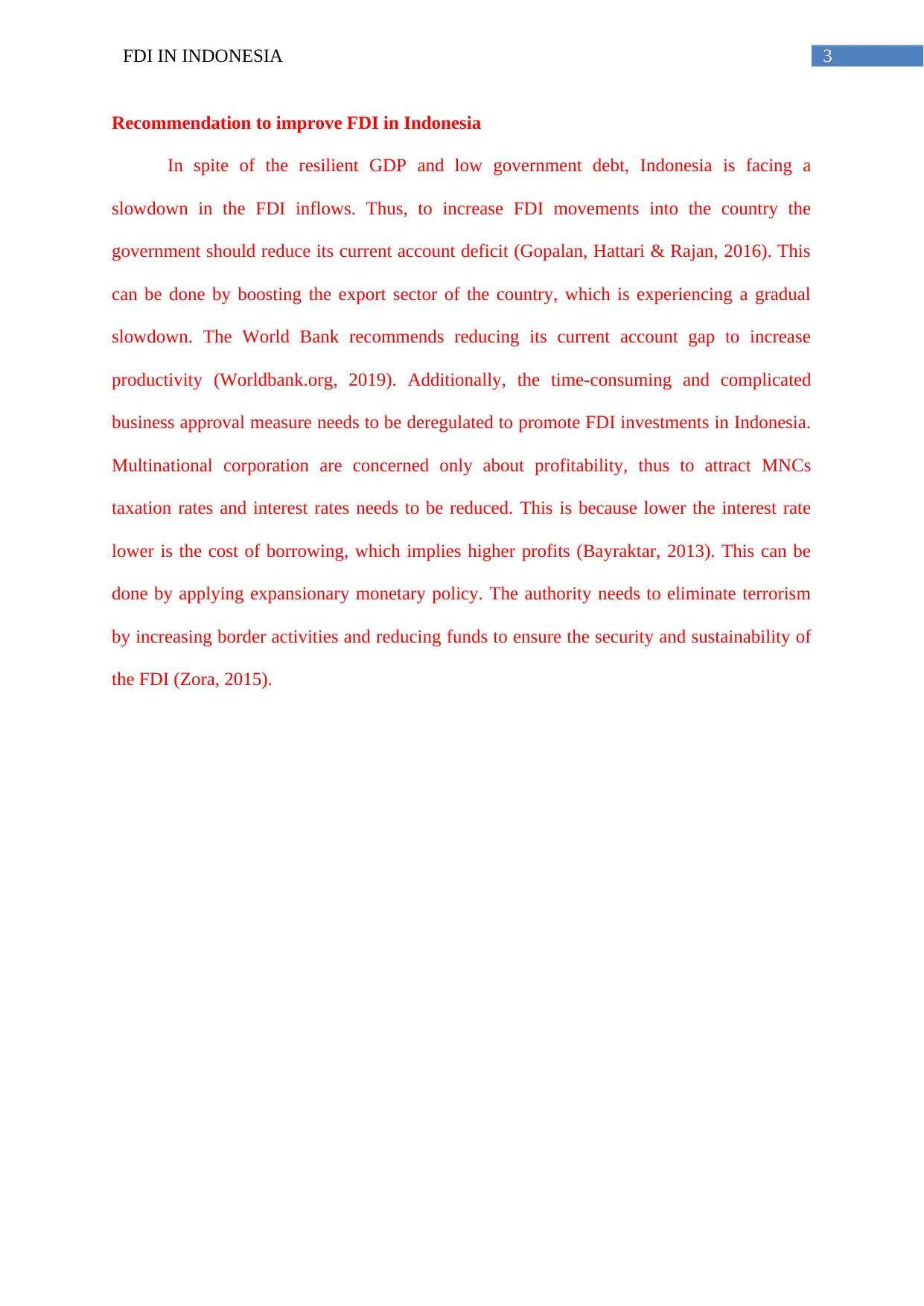
3FDI IN INDONESIA
Recommendation to improve FDI in Indonesia
In spite of the resilient GDP and low government debt, Indonesia is facing a
slowdown in the FDI inflows. Thus, to increase FDI movements into the country the
government should reduce its current account deficit (Gopalan, Hattari & Rajan, 2016). This
can be done by boosting the export sector of the country, which is experiencing a gradual
slowdown. The World Bank recommends reducing its current account gap to increase
productivity (Worldbank.org, 2019). Additionally, the time-consuming and complicated
business approval measure needs to be deregulated to promote FDI investments in Indonesia.
Multinational corporation are concerned only about profitability, thus to attract MNCs
taxation rates and interest rates needs to be reduced. This is because lower the interest rate
lower is the cost of borrowing, which implies higher profits (Bayraktar, 2013). This can be
done by applying expansionary monetary policy. The authority needs to eliminate terrorism
by increasing border activities and reducing funds to ensure the security and sustainability of
the FDI (Zora, 2015).
Recommendation to improve FDI in Indonesia
In spite of the resilient GDP and low government debt, Indonesia is facing a
slowdown in the FDI inflows. Thus, to increase FDI movements into the country the
government should reduce its current account deficit (Gopalan, Hattari & Rajan, 2016). This
can be done by boosting the export sector of the country, which is experiencing a gradual
slowdown. The World Bank recommends reducing its current account gap to increase
productivity (Worldbank.org, 2019). Additionally, the time-consuming and complicated
business approval measure needs to be deregulated to promote FDI investments in Indonesia.
Multinational corporation are concerned only about profitability, thus to attract MNCs
taxation rates and interest rates needs to be reduced. This is because lower the interest rate
lower is the cost of borrowing, which implies higher profits (Bayraktar, 2013). This can be
done by applying expansionary monetary policy. The authority needs to eliminate terrorism
by increasing border activities and reducing funds to ensure the security and sustainability of
the FDI (Zora, 2015).
Paraphrase This Document
Need a fresh take? Get an instant paraphrase of this document with our AI Paraphraser
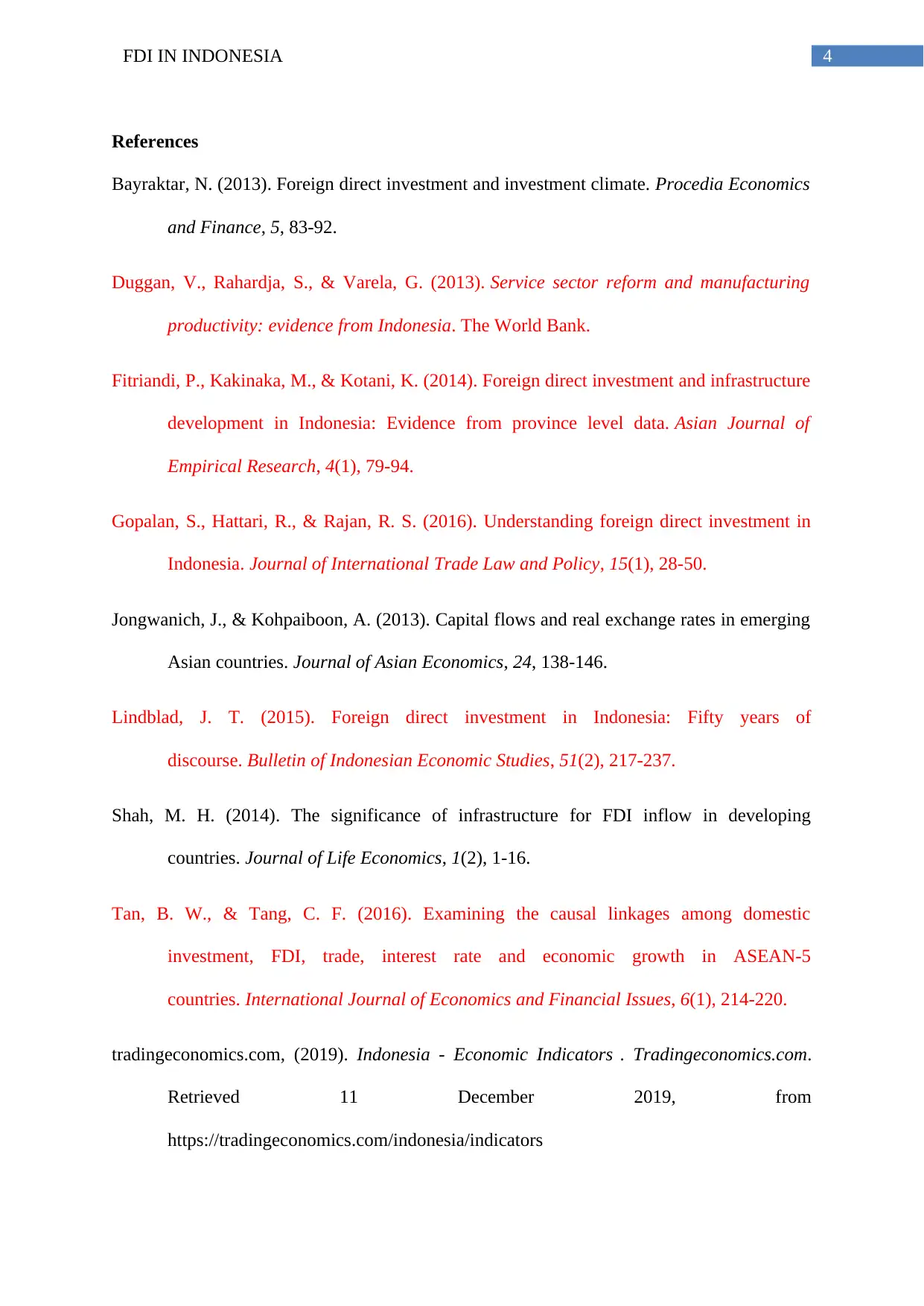
4FDI IN INDONESIA
References
Bayraktar, N. (2013). Foreign direct investment and investment climate. Procedia Economics
and Finance, 5, 83-92.
Duggan, V., Rahardja, S., & Varela, G. (2013). Service sector reform and manufacturing
productivity: evidence from Indonesia. The World Bank.
Fitriandi, P., Kakinaka, M., & Kotani, K. (2014). Foreign direct investment and infrastructure
development in Indonesia: Evidence from province level data. Asian Journal of
Empirical Research, 4(1), 79-94.
Gopalan, S., Hattari, R., & Rajan, R. S. (2016). Understanding foreign direct investment in
Indonesia. Journal of International Trade Law and Policy, 15(1), 28-50.
Jongwanich, J., & Kohpaiboon, A. (2013). Capital flows and real exchange rates in emerging
Asian countries. Journal of Asian Economics, 24, 138-146.
Lindblad, J. T. (2015). Foreign direct investment in Indonesia: Fifty years of
discourse. Bulletin of Indonesian Economic Studies, 51(2), 217-237.
Shah, M. H. (2014). The significance of infrastructure for FDI inflow in developing
countries. Journal of Life Economics, 1(2), 1-16.
Tan, B. W., & Tang, C. F. (2016). Examining the causal linkages among domestic
investment, FDI, trade, interest rate and economic growth in ASEAN-5
countries. International Journal of Economics and Financial Issues, 6(1), 214-220.
tradingeconomics.com, (2019). Indonesia - Economic Indicators . Tradingeconomics.com.
Retrieved 11 December 2019, from
https://tradingeconomics.com/indonesia/indicators
References
Bayraktar, N. (2013). Foreign direct investment and investment climate. Procedia Economics
and Finance, 5, 83-92.
Duggan, V., Rahardja, S., & Varela, G. (2013). Service sector reform and manufacturing
productivity: evidence from Indonesia. The World Bank.
Fitriandi, P., Kakinaka, M., & Kotani, K. (2014). Foreign direct investment and infrastructure
development in Indonesia: Evidence from province level data. Asian Journal of
Empirical Research, 4(1), 79-94.
Gopalan, S., Hattari, R., & Rajan, R. S. (2016). Understanding foreign direct investment in
Indonesia. Journal of International Trade Law and Policy, 15(1), 28-50.
Jongwanich, J., & Kohpaiboon, A. (2013). Capital flows and real exchange rates in emerging
Asian countries. Journal of Asian Economics, 24, 138-146.
Lindblad, J. T. (2015). Foreign direct investment in Indonesia: Fifty years of
discourse. Bulletin of Indonesian Economic Studies, 51(2), 217-237.
Shah, M. H. (2014). The significance of infrastructure for FDI inflow in developing
countries. Journal of Life Economics, 1(2), 1-16.
Tan, B. W., & Tang, C. F. (2016). Examining the causal linkages among domestic
investment, FDI, trade, interest rate and economic growth in ASEAN-5
countries. International Journal of Economics and Financial Issues, 6(1), 214-220.
tradingeconomics.com, (2019). Indonesia - Economic Indicators . Tradingeconomics.com.
Retrieved 11 December 2019, from
https://tradingeconomics.com/indonesia/indicators
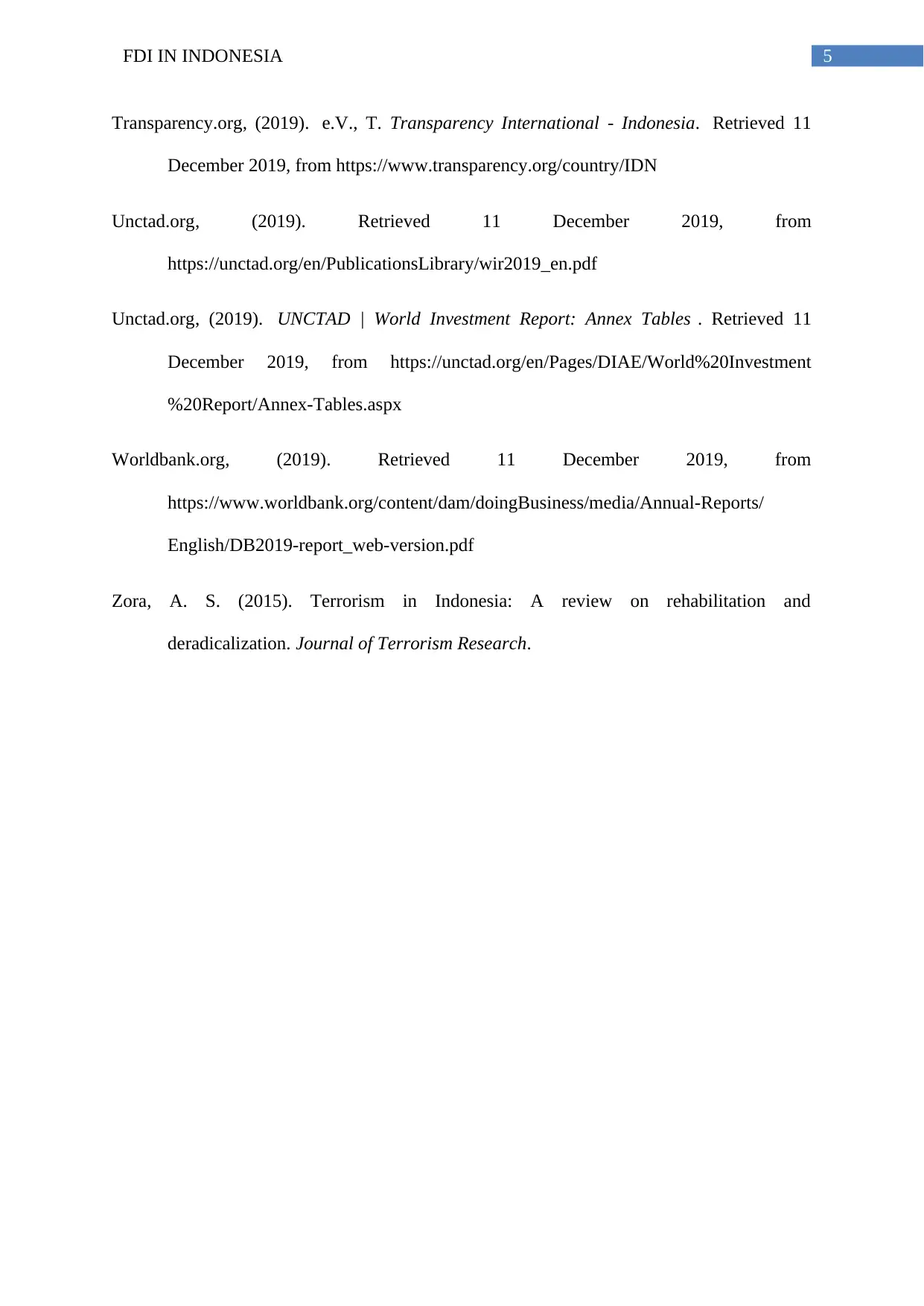
5FDI IN INDONESIA
Transparency.org, (2019). e.V., T. Transparency International - Indonesia. Retrieved 11
December 2019, from https://www.transparency.org/country/IDN
Unctad.org, (2019). Retrieved 11 December 2019, from
https://unctad.org/en/PublicationsLibrary/wir2019_en.pdf
Unctad.org, (2019). UNCTAD | World Investment Report: Annex Tables . Retrieved 11
December 2019, from https://unctad.org/en/Pages/DIAE/World%20Investment
%20Report/Annex-Tables.aspx
Worldbank.org, (2019). Retrieved 11 December 2019, from
https://www.worldbank.org/content/dam/doingBusiness/media/Annual-Reports/
English/DB2019-report_web-version.pdf
Zora, A. S. (2015). Terrorism in Indonesia: A review on rehabilitation and
deradicalization. Journal of Terrorism Research.
Transparency.org, (2019). e.V., T. Transparency International - Indonesia. Retrieved 11
December 2019, from https://www.transparency.org/country/IDN
Unctad.org, (2019). Retrieved 11 December 2019, from
https://unctad.org/en/PublicationsLibrary/wir2019_en.pdf
Unctad.org, (2019). UNCTAD | World Investment Report: Annex Tables . Retrieved 11
December 2019, from https://unctad.org/en/Pages/DIAE/World%20Investment
%20Report/Annex-Tables.aspx
Worldbank.org, (2019). Retrieved 11 December 2019, from
https://www.worldbank.org/content/dam/doingBusiness/media/Annual-Reports/
English/DB2019-report_web-version.pdf
Zora, A. S. (2015). Terrorism in Indonesia: A review on rehabilitation and
deradicalization. Journal of Terrorism Research.
⊘ This is a preview!⊘
Do you want full access?
Subscribe today to unlock all pages.

Trusted by 1+ million students worldwide
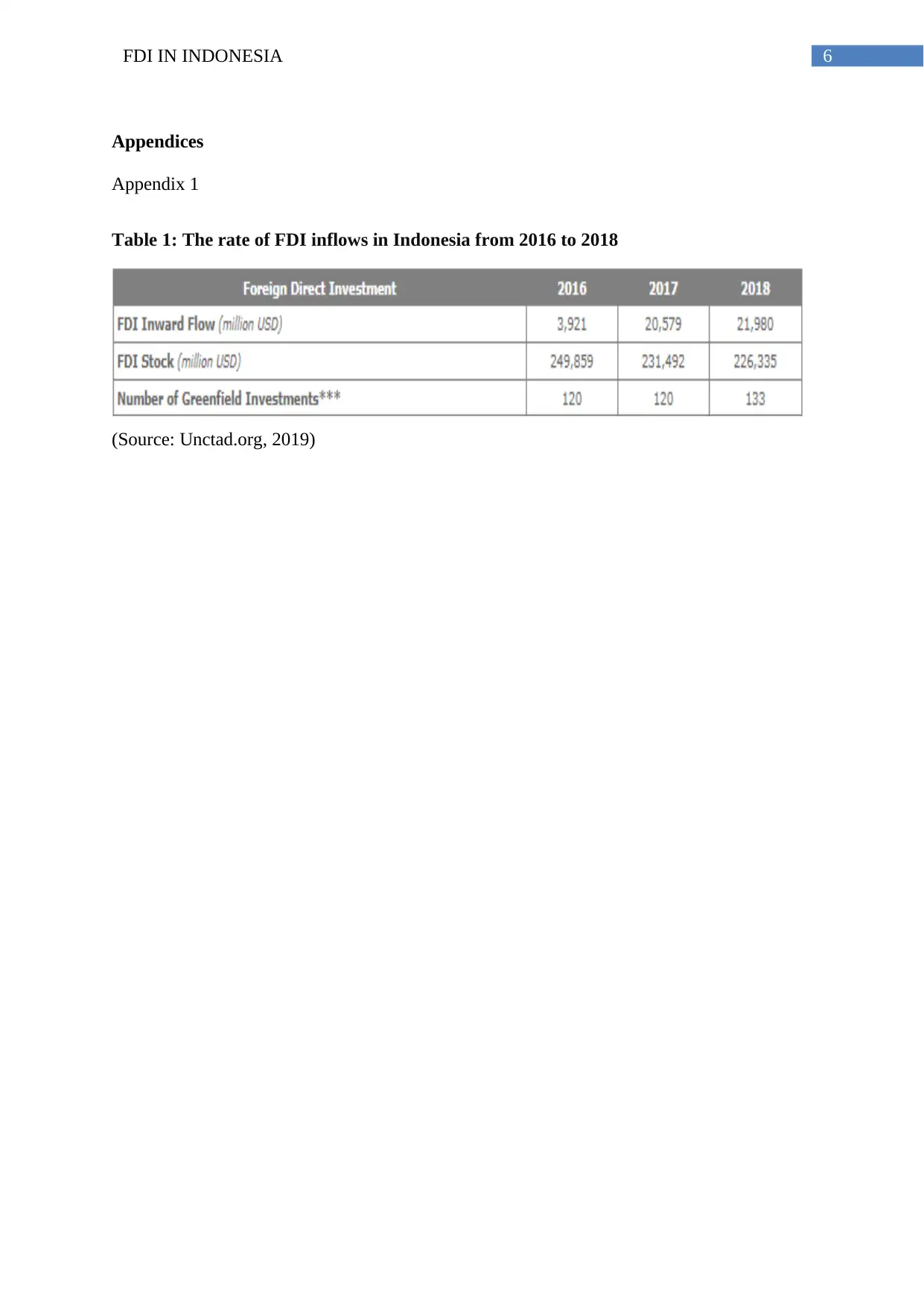
6FDI IN INDONESIA
Appendices
Appendix 1
Table 1: The rate of FDI inflows in Indonesia from 2016 to 2018
(Source: Unctad.org, 2019)
Appendices
Appendix 1
Table 1: The rate of FDI inflows in Indonesia from 2016 to 2018
(Source: Unctad.org, 2019)
1 out of 7
Related Documents
Your All-in-One AI-Powered Toolkit for Academic Success.
+13062052269
info@desklib.com
Available 24*7 on WhatsApp / Email
![[object Object]](/_next/static/media/star-bottom.7253800d.svg)
Unlock your academic potential
Copyright © 2020–2025 A2Z Services. All Rights Reserved. Developed and managed by ZUCOL.





